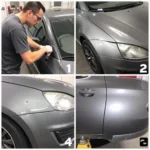Car painting repair, whether a minor touch-up or a full-blown respray, requires the right tools for a professional finish. Using appropriate tools for car painting repair ensures a smooth, even, and durable result, preventing common issues like orange peel, fish eyes, and runs. Let’s explore the essential tools you’ll need for various car painting repair scenarios. Choosing the correct tools can significantly impact the final outcome of your project.
After cleaning the damaged area, applying a specialized car paint micro-blistering repair razor can effectively remove the blistered paint without damaging the surrounding area. This is a crucial first step in many paint repair projects. You might even find this tool useful if you need car paint dent repair at a Meineke shop.
Prepping the Surface: The Foundation of a Flawless Finish
Before any paint touches the car, proper surface preparation is crucial. This involves cleaning, sanding, and priming the area to be repaired. Key tools for this stage include:
- Sandpaper: A range of grits, from coarse to fine, is essential for smoothing out imperfections and creating a suitable surface for paint adhesion. Start with a coarser grit to remove any rust or deep scratches, gradually moving to finer grits for a smooth finish.
- Sanding blocks: These provide an even surface for sanding, preventing uneven pressure and ensuring a uniform result. Different sizes and shapes cater to various panel contours.
- Masking tape and paper: Protect surrounding areas from overspray. Choose high-quality masking tape designed for automotive use to prevent paint bleeding.
- Grease and wax remover: Thoroughly clean the area to be painted with a dedicated grease and wax remover. This ensures proper paint adhesion and prevents fish eyes (small craters in the paint).
- Primer: Applying primer after sanding creates a uniform base for the paint to adhere to, promoting better color coverage and durability.
Applying the Paint: Tools for a Professional Look
Once the surface is prepped, the next step is applying the paint. Whether you’re using a spray gun, aerosol can, or touch-up pen, the right tools make all the difference.
- Spray gun (HVLP or gravity feed): For larger repairs or full resprays, an HVLP (High Volume, Low Pressure) or gravity-feed spray gun offers the best control and minimizes overspray. Practice on scrap metal before tackling your car.
- Aerosol cans: Convenient for smaller repairs and touch-ups, aerosol cans provide a quick and easy way to apply paint. Shake the can thoroughly before use and apply thin, even coats.
- Touch-up pens: Ideal for minor chips and scratches, touch-up pens allow for precise application and minimize the need for extensive masking.
- Paint strainers: Filtering the paint through a strainer before spraying removes any contaminants that could clog the spray gun or create imperfections in the finish.
You might consider Cheshire car paint repair or car dent and paint repair in Melbourne for professional assistance if the damage is extensive.
Finishing Touches: Achieving a Showroom Shine
After the paint has dried, the final step is to achieve a smooth, glossy finish. This involves wet sanding, polishing, and buffing.
- Wet sanding paper: Using progressively finer grits of wet sanding paper removes any orange peel (a textured, bumpy finish) and creates a smooth surface for polishing.
- Polishing compound: Apply polishing compound with a polishing pad or machine to remove any fine scratches and restore gloss.
- Buffing pads and machine: A buffer, either rotary or dual-action, combined with the appropriate buffing pad, creates a showroom shine. Start with a cutting pad to remove imperfections and finish with a polishing pad for ultimate gloss.
If you’re looking for advice on repairing chips in your car’s paint, consider exploring the best way to repair chips in car paint.
Conclusion: The Right Tools for the Job
Investing in the right tools for car painting repair ensures a professional-looking finish and avoids costly mistakes. Whether you’re tackling a minor touch-up or a full respray, having the appropriate tools at your disposal will significantly improve the outcome and save you time and frustration. With proper preparation and the right tools for car painting repair, you can achieve a stunning result.
FAQ
- What grit sandpaper should I start with for car paint repair?
- What is the difference between an HVLP and gravity-feed spray gun?
- How do I prevent orange peel when painting a car?
- What is the purpose of wet sanding after painting?
- How do I choose the right buffing pad for my car?
- What can I do about micro-blistering on my car’s paint?
- What are my options for dent and paint repair?
Common Car Painting Repair Scenarios
- Scratches: From minor key scratches to deeper gouges, understanding the appropriate repair method and tools is essential.
- Stone Chips: Common occurrences, stone chips require prompt attention to prevent rust and further damage. Touch-up pens or aerosol cans are often sufficient for these repairs.
- Dents with Paint Damage: Repairing dents often necessitates paint correction, requiring a combination of bodywork tools and painting equipment.
- Fading and Oxidation: Restoring faded or oxidized paint involves compounding, polishing, and waxing.
Further Resources for Car Repair
- Explore articles on specific car paint repair issues like micro-blistering and dent repair.
- Learn about the best practices for chip repair and other common paint problems.
- Find information on professional car paint repair services in your area.
Need further assistance? Contact us via WhatsApp: +1(641)206-8880 or email [email protected]. Our 24/7 customer support team is ready to help.

